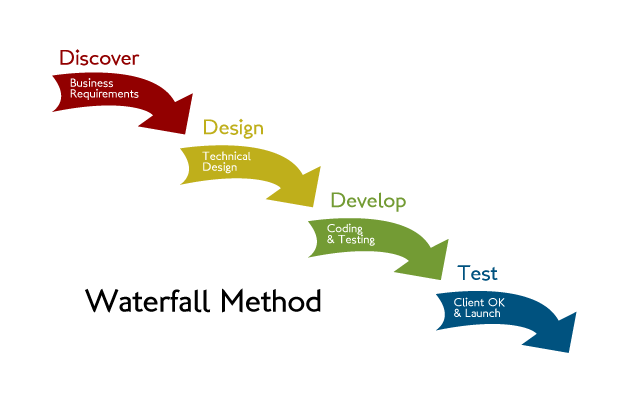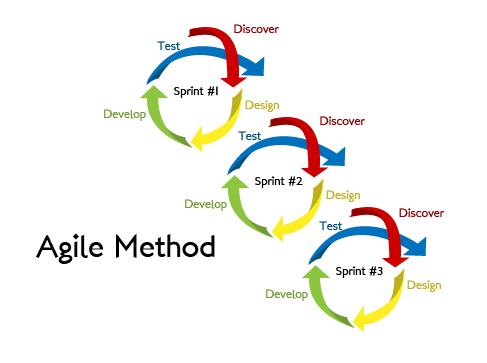There is a new Hybrid project management framework that has been growing in the last few years, in this article I want to try to define what we should look out in order to apply the right methodology to your project.
Project Management has been around for a long time but started to be formalised into a discipline only in the 19th century. The evolution of project management as a discipline accelerated in the last 20 years, since the Agile Manifesto was published (2001). Multiple methodologies are now available to use for different types of projects and teams, how do you choose the best one for your needs? in this article I will try to answer what can work for you and your team/project.
There are multiple project management methodologies you can use but the most used are Agile ( XP, Scrum, Kanban… ) and Waterfall. Let’s start giving an overview of Waterfall and Agile an their principles.
Waterfall
Waterfall is the father of all methodology, this is the first methodology you usually learn in project management. It rely on clear requirements gathering with clear outcome. It is based on agreed requirements and tackle the project all at once, planning from start to finish at the beginning of the project.It has approval points for each phase of the project and once each phase is passed it won’t allow to go back.

Advantages
- Clearly defined plan, timelines, tasks and cost for the team members.
- Easy to maintain and plan future changes to the product as it will be fully documented.
- Tasks are easy to handover to new team members as fully documented
Disadvantages
- Not flexible, once one of the phase/deliverable is approved/closed it doesn’t allow to go back to it. Unforeseen changes to the original plan/scope will impact time and cost for the final delivery
- Low client engagement Client is involved only in the acceptance/approval for each of the deliveries, when it could be too late to make changes.
- Focus is on delivery not on best product as this should have been clearly outlined at the beginning.
Usually it is best used for well defined projects, when the requirements and the outcome can be clearly defined, not too complex and with defined stakeholders. It works very well if projects are repetitive and straightforward. In this case it can be really effective creating project templates for the running of the projects,. It will save time in estimating and execution of the projects. It is not as flexible as other methodologies as once one phase of the project is signed off you can’t go back without compromising the all project. So the main characteristic are:
- Requirements can be clearly defined by the project stakeholder.
- Detailed documentation that stakeholder can review and sign off.
- Changes to the initial plan are minimal.
Agile
Agile manifesto is an evolution from the waterfall methodology, as said there are different agile methodologies that can be applied, but all of them are based on the original Agile manifesto, the 12 principles of Agile are based on this manifesto.
- Individuals and interactions over processes and tools
- Working software over comprehensive documentation
- Customer collaboration over contract negotiation
- Responding to change over following a plan
Agile tackle the project in a more flexible manner, allowing feedback and changes at any point of the project.

Advantages
- Higher client satisfaction, the product owner (Client) is part of the team and will have visibility over the full project. This implies engagement and customer satisfaction.
- Rapid delivery, breaking down the project in small size deliverable to fit the sprint time box.
- Adapt to changes with iterative planning and feedback loop. The team is able to continuously align the delivered product with desired business needs
Disadvantages
- Training and organisational transformation, implementing Agile successfully in an organisation requires a considerable amount of training and skills at all levels from developers to the managers and clients . Implementing Agile without fully understanding the principles and organisational support is not very effective.
- Documentation and maintainability, Constant changes to the product without a robust document log make it difficult to handover or maintain the product for non team members.
- Scalability, Agile works well with a small team (usually between 5-9 people) but when you have to manage interrelationships between those small teams maintaining a united agile approach.
Hybrid or blended
Since the Agile became more popular Waterfall seems to be the bad guy in the room: old, slow to embrace changes and stubborn. While Agile is the new kid on the block: young fast and accommodating. Hybrid would be the men in the room, taking charge of his life and decisions based on experience. Hybrid solutions may take bits from other methodologies if suitable and beneficial to the project (Critical path, PERT, Kanban….).
Hybrid project management will adapt the best of both world to the project, based on the characteristics of the project or type of projects.
This is not a methodology as is an adaptation of different methodologies to the projects and team needs. This will depend from many factors you may have in your p[project for example:
- Lack of a Product owner – client engagement.
- Need for accurate documentation and step by step approvals.
- Team skill set
- Scale the process using multiple agile and non agile teams.
- project definition
- project timing and deadlines
Some example of Hybrid project management are :
- Utilise a waterfall and critical path plan, break down each phases in and running it in agile sprints
- Utilise a mix of Scrum teams and other non Agile teams to implement a product, having clear handover between the teams.
Advantages
- Team and client agree on the deliverables at an early stage in the development, giving a better understanding on the final outcome of the sprint .
- Scalability, having a traditional approach to organisational structure it makes easier to manage bigger teams.
- Flexible as it will adapt the methodologies to the team / organisation and type of project. Each implementation will be unique and can evolve to fit unique needs of the organisation or project.
Disadvantages
- Training and documentation. You will need to document the new ways of working and train teams to follow it to avoid confusion.
- For bigger organisations team members roles change and it could be difficult to implement without clear R&R, specially for PMs
Conclusion
Hybrid methodology is not the answer to everything, but when applied by experienced PM to accommodate different projects and client needs it helps to avoid disruption to the organisation. As Hybrid is by definition flexible and adaptable to projects and organisation it could be the easiest way to implement changes that can have immediate effect. This doesn’t mean that it is the answer to all the problems.
Choosing the right methodology for an organisation/team or project depends from many factors. I tried to simplify them in the table below, knowing that there are many more factors to influence the choice, depending on specific projects and organisation.
Waterfall
- Clearly defined project scope from the beginning
- Need for clear deadline and documentation
- Client only available for reviews and approval
Agile
- Not fully defined project scope
- Small project team
- Clients and organisation fully engaged and available
Hybrid
- Not fully defined project scope
- Big size teams
- Client and organisation not fully engaged
Which methodology to use
I tried to make a simple formula to find out the most suitable management methodology based on the following organisational and projects criteria:
Organisation readiness
| Team size | Usually a good size team for implementing agile is 4-9 people, more than that it become problematic |
| Organisation Engagement | The level of engagement in adopting a new methodology can impact on the implementation of it. |
| Agile skill set | Agile skillset and training of the team is a key to the success. |
Project characteristics
| Project timing | Project timing will impact on the best methodology to use 1-2 weeks project are usually better done in a waterfall manner |
| Scope definition | How well defined is the scope and the outcome of the project at the beginning helps to define the methodology. |
| Client engagement | How engaged is the client? Is the client willing to be fully engaged or only wan t to be in the approval / review of the deliverables? |

I am a problem solver, a communicator and a digital entrepreneur. I have more than 20 years experience in digital and advertising, I went through all the digital revolution / evolution, starting my career as a developer and ending up on the dark side as a Manager.





